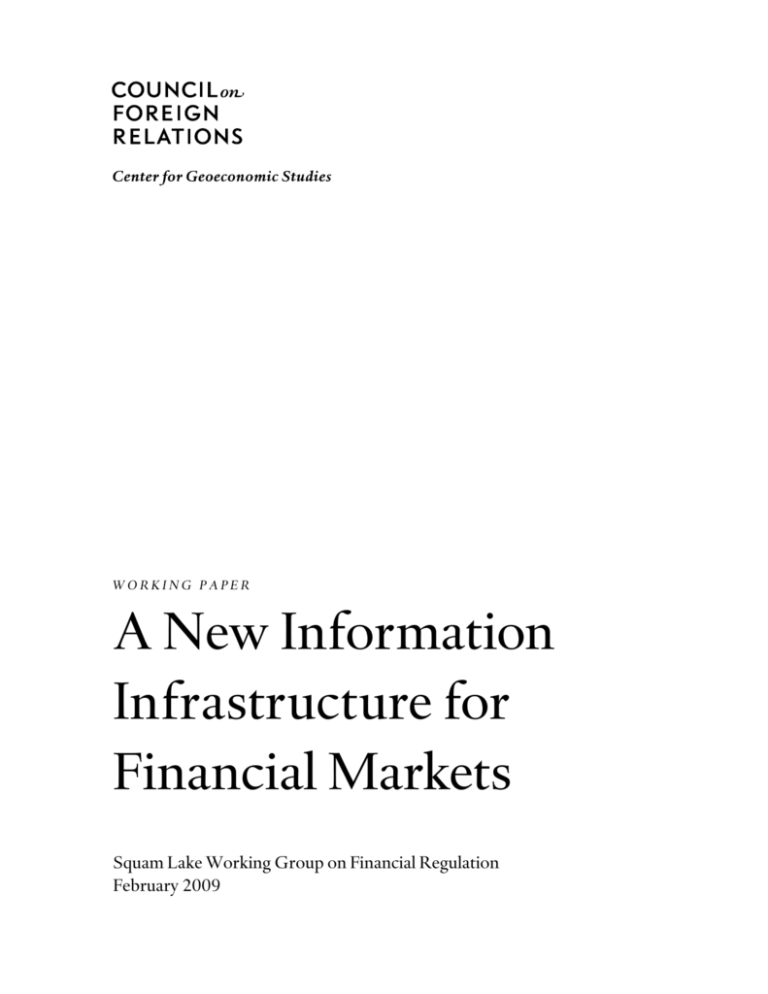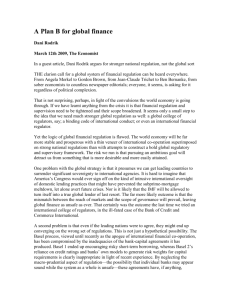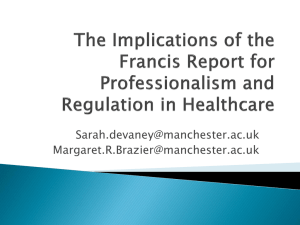
WORKING PAPER
A New Information
Infrastructure for
Financial Markets
Squam Lake Working Group on Financial Regulation
February 2009
1
Squam Lake Working Group on Financial Regulation
The Squam Lake Working Group on Financial Regulation is a nonpartisan, nonaffiliated group of fifteen
academics who have come together to offer guidance on the reform of financial regulation.
The group first convened in fall 2008, amid the deepening capital markets crisis. Although informed by
this crisis—its events and the ongoing policy responses—the group is intentionally focused on longer-term
issues. It aspires to help guide reform of capital markets—their structure, function, and regulation. This guidance is based on the group’s collective academic, private sector, and public policy experience.
To achieve its goal, the Squam Lake Working Group is developing a set of principles and their implications that are aimed at different parts of the financial system: at individual firms, at financial firms collectively,
and at the linkages that connect financial firms to the broader economy.
The members of the group are
Martin N. Baily
Brookings Institution
Frederic S. Mishkin
Columbia University
Andrew B. Bernard
Dartmouth College
Raghuram G. Rajan
University of Chicago
John Y. Campbell
Harvard University
David S. Scharfstein
Harvard University
John H. Cochrane
University of Chicago
Robert J. Shiller
Yale University
Douglas W. Diamond
University of Chicago
Hyun Song Shin
Princeton University
Darrell Duffie
Stanford University
Matthew J. Slaughter
Dartmouth College
Kenneth R. French
Dartmouth College
René M. Stulz
Ohio State University
Anil K Kashyap
University of Chicago
2
A New Information Infrastructure for Financial Markets
INTRODUCTION
Information about prices and quantities of assets lies at the heart of well-functioning capital markets.
In the current financial crisis, it has become clear that many important actors—both firms and regulatory agencies—have not had sufficient information. This paper proposes a new regulatory regime for
gathering and disseminating financial market information. We argue that government regulators
need a new infrastructure to collect and analyze adequate information from large (systemically important) financial institutions. Our new information framework would bolster the government’s ability to foresee, contain, and, ideally, prevent disruptions to the overall financial services industry.
WHY INFORMATION IS CRITICAL AND WHAT INFORMATION GAPS
CURRENTLY EXIST
Much of the information regulators currently collect from U.S. financial institutions focuses on the
health and potential failure of each one individually. Regulators collect far less information about the
systemic interactions between all these institutions. The failure of one bank, for example, might have
little impact on other intermediaries, while the failure of another bank might have a devastating impact on the whole financial system. Knowledge of such differences is important for effective regulation of the financial system.
Each financial institution is vulnerable to institution-specific risks, such as the performance of its
particular assets and the quality of its management. But financial institutions also face two important
forms of systemic risk. Counterparty risk arises when one institution owes money to a trading partner,
either because the trading partner has posted collateral with the institution or because the partner has
unrealized gains on the contracts that link the firms. The trading partner has counterparty risk because it will suffer losses if the other firm defaults.
Fire-sale risk is a bit more complicated. Firms often push security prices down when they sell large
positions. Part of the price drop is permanent and is attributable to (1) any information revealed
by the firm’s decision to sell at the current price and (2) the fact that others must now absorb the
risk formerly borne by the firm. Fire-sale risk arises because the price drop also has a second—
temporary—component. If the firm tries to sell a large position quickly, it must offer a price concession to attract the limited number of buyers who are currently in the market. The size of the temporary price concession depends on how much is being sold, how quickly the firm wants to sell, and
how many buyers are available and ready to trade.
As the name implies, the temporary part of the price drop is temporary; the price will eventually
move to the new permanent level. Nevertheless, the temporary component can have real effects. For
example, the temporary price concession reduces the amount a firm receives if it must sell large posi-
3
tions quickly to reduce its risk. The temporary component can also affect firms that do not sell but are
forced to mark their assets to another firm’s fire-sale price when determining their capital requirements.
Fire-sale risk can be systemic for a couple of reasons. First, the magnitude of the temporary component of the price drop depends on how much is being sold. Thus, if many firms rush to the exit simultaneously, the price concession can be especially large. Second, because of mark to market accounting, fire sales by some firms may force others to liquidate positions to satisfy capital requirements. These successive sales can magnify the original temporary price drop and force more sales.
Because of counterparty and fire-sale risk, an otherwise sound firm can be dragged down by the
failure of others. As the insurer and lender of last resort for banks and many other financial institutions, the government needs sufficient information to monitor these risks. We believe that the government should collect information from all systemically important institutions, including both heavily regulated institutions such as large commercial banks, and less regulated institutions such as hedge
funds.
In order to monitor systemic risk, the government needs information about two broad categories
of financial instruments:
1. Derivative positions, such as forward contracts, swaps, and options. Since the firm’s payoff on
these contracts depends on the performance of a clearing house or trading partner, they contribute to counterparty risk. This information should be detailed enough to allow regulators to
identify significant counterparties shared by many systemically important institutions, such
as Lehman Brothers and AIG during the current crisis.
2. More general asset positions, such as bonds, mortgages, and asset backed securities. Together
with the information about derivative positions, regulators can combine this information
across institutions to identify large aggregate positions that create systemic fire-sale risk. Recent examples of large common holdings include real estate CMOs and credit card debt.
What specific information is needed about these positions? A starting point is the current valuation of a firm’s positions, but this is not enough by itself. The government also needs to be able to
assess the risk exposures of the firm’s positions, the sensitivities of their values to changes in market
conditions. This is particularly important for derivative positions, which are often structured so that
cash transfers between counterparties keep current values at or close to zero, but which can create
large gains or losses as market conditions change.
The importance of linking this information across institutions is obvious. Regulators cannot assess the status of the financial system without knowledge of the interactions between firms. Currently, U.S. regulators do not systematically gather and analyze much of the information outlined above, and the
information they do have is often difficult or impossible to aggregate across institutions. This constrains the
government’s ability to foresee, contain, and, ideally, prevent disruptions to the overall financial services industry. The September 2008 failure of AIG is a good example. It is now clear that few, if any, regulators understood AIG’s outsized credit default swap positions until AIG itself approached regulators
under great duress.
4
OUR PROPOSAL: A NEW INFRASTRUCTURE FOR
INFORMATION COLLECTION AND ANALYSIS BY REGULATORS
Currently, different government regulators do collect some information from financial institutions,
such as the quarterly 10Q accounting statements firms must file with the Securities and Exchange
Commission and the Reports of Condition and Income banks must file with the Federal Reserve. But
this information does not cover the full set outlined above. Government regulators need new authority
and a new infrastructure to collect and analyze adequate information from all financial institutions. This new
information regime should be structured with five main features.
First, all large financial institutions should report information about asset positions and risks to regulators
each quarter. Quarterly disclosure will balance timeliness against reporting burden. “Window dressing,” in which an institution alters its exposures at quarter-end to mask its typical risk, is a potential
problem. But we do not think it will undermine the usefulness of our proposed regime, and its incidence will be curbed by the cost of temporarily shifting positions.
We stress that in this new framework, greater information would be collected from some institutions that currently face limited oversight, such as hedge funds. We are sensitive to the potential burden a reporting requirement such as this can create for these firms. Nevertheless, as the hedge fund
Long-Term Capital Management demonstrated vividly in 1998, these institutions can have systemic
effects.
More generally, one of the benefits of broader information disclosure could be to force more
companies to generate and aggregate this information themselves. This could foster better internal
risk management in firms, something that seemed acutely lacking in many companies in the run-up
to the current financial crisis.
Second, to maximize the value of information collected, regulators need to standardize the process used to
measure valuations and risk exposures. Where they are available, firms should report the current market
values of their asset and derivatives positions. Market values should also be used as inputs when firms
calculate their risk exposures. When model-based valuations are used for hard-to-value assets, regulators should enforce some consistency across institutions. One possibility is for each firm to value its
positions using a standard set of models. Regulators should also develop a standard set of factors
(such as movements in short-term and long-term interest rates, domestic and foreign stock returns,
real estate prices, and foreign currencies) that institutions should use to assess their risks. Firms could
then report the dollar amount of their gains and losses from specific changes in these factors, both for
the assets they own and for their derivative positions. The asset values and risk sensitivities should be
reported for standardized asset classes and the sensitivities for derivative positions should be broken
down by counterparty. Of course, the asset classes and standard factors must be redefined periodically as market conditions change.
Although we advocate the use of market values wherever possible in value and risk reporting, in
this paper we are not arguing for or against using market values for other purposes, such as mark to
market accounting or the calculation of regulatory capital for commercial banks. It is clear that the
advantages of market valuations outweigh the disadvantages when measuring systemic risks, but the
more general use of market values is a separate issue that we do not address here.
Third, to foster sound analysis of the information collected, different regulatory agencies need authority to
share information. We see at least two distinct merits in widespread information sharing across agen-
5
cies. One is to allow each agency to better conduct its specific functions. The other is to foster among
all agencies greater awareness of systemic patterns.
Fourth, after some time lag the information collected by regulators each quarter should be released to the
private sector. Regulatory capacity is limited: despite the talented individuals with sound intentions
throughout regulatory agencies, the inherent complexity of financial markets means potential problems can be difficult to recognize and respond to. Given this, there is high value in complementing
government analysis of financial-system information with that of private actors.
That said, it is important to protect proprietary business models and incentives to innovate. Public
disclosure of a firm’s sensitivities also raises concerns about predatory trading by competitors. To
mitigate these problems, public disclosure will be delayed and the length of this delay will depend on
the extent to which information is aggregated. For example, industry-wide exposures should be released soon after the information is collected, while exposures for individual firms may be withheld
for three, six, or even twelve months.
Fifth, to elevate the importance of financial-system information, regulators should prepare for the president and Congress an annual “risk of the financial system” report. This report could provide summary
statistics for different points in the year on asset positions, fire-sale exposures, and counterparty
exposures for various parts of the U.S. financial system. The report will add value both directly,
through its contents, and indirectly, by fostering a higher public profile for sound regulation of capital markets.
CONCLUSION
The new information infrastructure for capital markets that we have outlined in this paper would
likely need new legislation to be integrated into the existing procedures used by financial-market regulators such as the Federal Reserve, the Federal Deposit Insurance Corporation, the Securities and
Exchange Commission, and the Commodities and Futures Trading Commission. Guidance for how
best to create this infrastructure would likely be needed from heads of these (and other) agencies.
The Council on Foreign Relations (CFR) is an independent, nonpartisan membership organization,
think tank, and publisher dedicated to being a resource for its members, government officials, business executives, journalists, educators and students, civic and religious leaders, and other interested
citizens in order to help them better understand the world and the foreign policy choices facing the
United States and other countries. Founded in 1921, CFR carries out its mission by maintaining a
diverse membership, with special programs to promote interest and develop expertise in the next
generation of foreign policy leaders; convening meetings at its headquarters in New York and in
Washington, DC, and other cities where senior government officials, members of Congress, global
leaders, and prominent thinkers come together with CFR members to discuss and debate major international issues; supporting a Studies Program that fosters independent research, enabling CFR
scholars to produce articles, reports, and books and hold roundtables that analyze foreign policy issues and make concrete policy recommendations; publishing Foreign Affairs, the preeminent journal
on international affairs and U.S. foreign policy; sponsoring Independent Task Forces that produce
reports with both findings and policy prescriptions on the most important foreign policy topics; and
providing up-to-date information and analysis about world events and American foreign policy on its
website, CFR.org.
The Council on Foreign Relations takes no institutional position on policy issues and has no affiliation with the U.S. government. All statements of fact and expressions of opinion contained in its publications are the sole responsibility of the author or authors.
For further information about CFR or this paper, please write to the Council on Foreign Relations,
58 East 68th Street, New York, NY 10065, or call the Director of Communications at 212.434.9400.
Visit CFR’s website, www.cfr.org.
Copyright © 2009 by the Squam Lake Group.
All rights reserved.
Printed in the United States of America.
This paper may not be reproduced in whole or in part, in any form beyond the reproduction permitted by Sections 107 and 108 of the U.S. Copyright Law Act (17 U.S.C. Sections 107 and 108) and
excerpts by reviewers for the public press, without express written permission from the Council on
Foreign Relations. For information, write to the Publications Office, Council on Foreign Relations,
58 East 68th Street, New York, NY 10065.










